
Bivalvia, in previous centuries referred to as the Lamellibranchiata and Pelecypoda, is a class of marine and freshwater molluscs that have laterally compressed bodies enclosed by a shell consisting of two hinged parts. As a group, bivalves have no head and they lack some usual molluscan organs, like the radula and the odontophore. The class includes the clams, oysters, cockles, mussels, scallops, and numerous other families that live in saltwater, as well as a number of families that live in freshwater. The majority are filter feeders. The gills have evolved into ctenidia, specialised organs for feeding and breathing. Most bivalves bury themselves in sediment, where they are relatively safe from predation. Others lie on the sea floor or attach themselves to rocks or other hard surfaces. Some bivalves, such as the scallops and file shells, can swim. Shipworms bore into wood, clay, or stone and live inside these substances.

Mactridae, common name the trough shells or duck clams, is a family of saltwater clams, marine bivalve mollusks in the order Venerida.
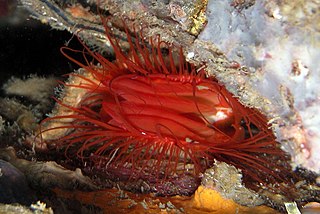
The Limidae or file shells are members of the only family of bivalve molluscs in the order Limida. The family includes 130 living species, assigned to 10 genera. Widely distributed in all seas from shallow to deep waters, the species are usually epifaunal or nestling, with many species building byssal nests for protection. The majority of species are capable of irregular swimming by waving their long mantle tentacles.
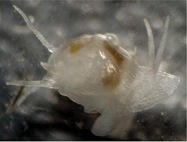
Galeommatidae is a family of small and very small saltwater clams, marine bivalve molluscs in the order Galeommatida.

Manzanellidae is a fossil family of bivalves, in the order Solemyida. They were previously considered containing fossil and recent members of Nucinellidae.
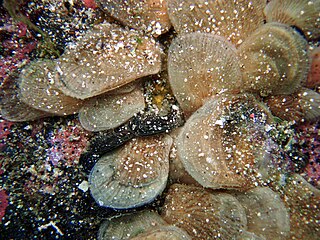
Isognomon is a genus of marine bivalve mollusks which is related to the pearl oysters.
Paleontology or palaeontology is the study of prehistoric life forms on Earth through the examination of plant and animal fossils. This includes the study of body fossils, tracks (ichnites), burrows, cast-off parts, fossilised feces (coprolites), palynomorphs and chemical residues. Because humans have encountered fossils for millennia, paleontology has a long history both before and after becoming formalized as a science. This article records significant discoveries and events related to paleontology that occurred or were published in the year 2010.
Tucetona bicolor is a species of dog cockle. Its shell is subtrigonal with 39 radial ribs. The ribs have with moderately shallow, very narrow interspaces, with very fine, very closely spaced commarginal ribs. The hinge plate is moderately wide and curved.

Periglypta is a genus of bivalves in the subfamily Venerinae of the family Veneridae.

Sanguinolaria tellinoides is a species of saltwater clam, marine bivalve molluscs of the family Psammobiidae.

Brisaster latifrons is a species of sea urchins of the family Schizasteridae. Their armour is covered with spines. Brisaster latifrons was first scientifically described in 1898 by Alexander Emanuel Agassiz.

Waldo is a genus of small marine clams in the family Galeommatidae. It includes five species which are all obligate commensals of sea urchins. They are found in the southern Atlantic and Antarctic Oceans, with the exception of Waldo arthuri which is found in the northeastern Pacific Ocean.

Tucetona is a genus of saltwater clams, marine bivalve molluscs in the family Glycymerididae, the bittersweet clams. Unlike other genera in the family, Tucetona species have a ribbed shell.

Ostreoidea is a taxonomic superfamily of bivalve marine mollusc, sometimes simply identified as oysters, containing two families. The ostreoids are characterized in part by the presence of a well developed axial rod. Anal flaps are known to exist within the family Ostreidae but not within the more-primitive Gryphaeidae. The scar from the adductor muscle is simple, with a single, central scar. In the majority, the right valve is less convex than the left.
Ascetoaxinus quatsinoensis is a species of saltwater clam, a bivalve mollusc in the family Thyasiridae. The shell of this species is unusual in that it has a lunule with scalloped edges.
Ascetoaxinus is a genus of saltwater clams, marine bivalve molluscs in the family Thyasiridae. The shells of species in this genus have a lunule with a scalloped margin.

Wallerconcha sarae is an extinct species of saltwater clam, a marine bivalve mollusc in the family Thyasiridae. The species was discovered in 2014 by Paul Valentich-Scott of the Santa Barbara Museum of Natural History and three scientists from the United States Geological Survey, Charles L. Powell, Brian D. Edwards and Thomas D. Lorenson by Arctic Ocean, whilst mapping the sea floor. It was discovered by accident inside a sediment core sample extracted more than 1.5 miles (2.5 km) below the surface of the ocean off the coast of northern Alaska, US, in 2010.
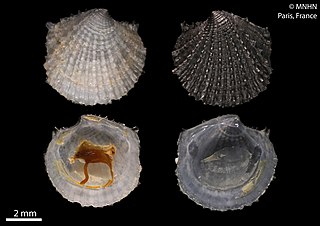
Lucinisca is a genus of saltwater clams, marine bivalve molluscs in the subfamily Lucininae of the family Lucinidae.
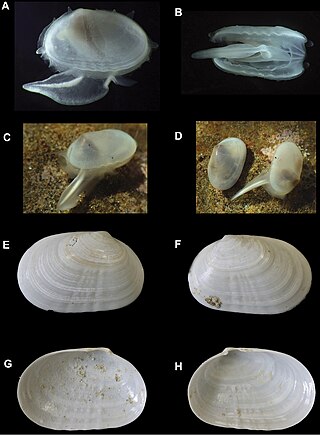
Cymatioa cookae, also known as Cymatioa cooki, is a species of saltwater clam, a bivalve mollusk, that is native to southern California. It was thought to be extinct since the Pleistocene era until four specimens were found living in Santa Barbara, California, between 2018 and 2019.














